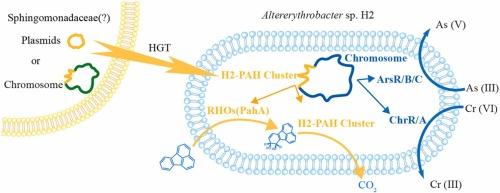Altererythrobacter sp. H2降解高分子量多环芳烃,同时解毒铬酸盐和亚砷酸盐
IF 11.3
1区 环境科学与生态学
Q1 ENGINEERING, ENVIRONMENTAL
引用次数: 0
摘要
在土壤和水中经常观察到高分子量多环芳烃与重金属铬和砷的共存,对公共卫生和环境管理构成挑战。然而,据报道,有限的微生物资源可以同时解毒PAHs、Cr(VI)和As(III),这限制了PAHs、Cr和As共污染土壤的生物修复。在这里,我们分离到了Altererythrobacter sp. H2,发现它可以降解多种多环芳烃,包括菲、氟蒽、芘、苯并[a]蒽和苯并[a]芘,并耐受和解毒高浓度的Cr(VI)和As(III)。基因组学、转录组学和生化分析表明,菌株H2通过水平转移的RHO基因簇、铬酸盐还原酶ChrR和亚砷酸盐抗性基因簇arsRBC降解多环芳烃、还原Cr(VI)和氧化As(III)。水平转移的多环芳烃降解基因簇编码Rieske双加氧酶三组分体系和降解多环芳烃所需的其他酶,这表明这些重金属解毒细菌在像菌株H2一样容纳了多环芳烃降解基因簇后,可能成为优秀的多环芳烃降解和重金属解毒剂。据我们所知,菌株H2是唯一报道的使用经典Rieske双加氧酶三组分系统初始降解多环芳烃的Altererythrobacter成员,也是唯一可以同时解毒多环芳烃、Cr(VI)和As(III)的成员。我们的研究揭示了Altererythrobacter成员对PAHs的降解机制,并证明了H2在PAHs和重金属污染物的生物修复中具有良好的潜力。本文章由计算机程序翻译,如有差异,请以英文原文为准。

Simultaneous high molecular weight PAHs degradation and chromate and arsenite detoxification by Altererythrobacter sp. H2
The cooccurrence of high molecular weight PAHs and heavy metals Cr and As is frequently observed in soil and water and challenges public health and environmental management. Yet the limited microbial resources were reported to simultaneously detoxify PAHs, Cr(VI) and As(III), which restricts the bioremediation of co-contaminated soil by PAHs, Cr and As. Here, we isolated Altererythrobacter sp. H2 and found it could degrade various PAHs, including phenanthrene, fluoranthene, pyrene, benzo[a]anthracene, and benzo[a]pyrene, and tolerate and detoxify high concentrations of Cr(VI) and As(III). Genomic, transcriptomic, and biochemical assays reveal strain H2 degrades PAHs, reduces Cr(VI) and oxidize As(III) via a horizontally transferred RHO gene cluster, a chromate reductase ChrR, and a arsenite resistance gene cluster arsRBC. The horizontally transferred PAHs-degrading gene cluster encodes the Rieske dioxygenase three-component system and other enzymes required for PAHs degradation, which suggested those heavy metal-detoxifying bacteria could be excellent PAHs-degrading and heavy metal-detoxifying agents after accommodating a PAHs degradation gene cluster like strain H2 did. To our knowledge, strain H2 is the only reported Altererythrobacter member that uses a classical Rieske dioxygenase three-component system to initial PAHs degradation and the only one could simultaneously detoxify PAHs, Cr(VI), and As(III). Our study provides insights into the PAHs degradation mechanism of Altererythrobacter members and demonstrates the excellent potential of H2 in the bioremediation of both PAHs and heavy metal pollutants.
求助全文
通过发布文献求助,成功后即可免费获取论文全文。
去求助
来源期刊

Journal of Hazardous Materials
工程技术-工程:环境
CiteScore
25.40
自引率
5.90%
发文量
3059
审稿时长
58 days
期刊介绍:
The Journal of Hazardous Materials serves as a global platform for promoting cutting-edge research in the field of Environmental Science and Engineering. Our publication features a wide range of articles, including full-length research papers, review articles, and perspectives, with the aim of enhancing our understanding of the dangers and risks associated with various materials concerning public health and the environment. It is important to note that the term "environmental contaminants" refers specifically to substances that pose hazardous effects through contamination, while excluding those that do not have such impacts on the environment or human health. Moreover, we emphasize the distinction between wastes and hazardous materials in order to provide further clarity on the scope of the journal. We have a keen interest in exploring specific compounds and microbial agents that have adverse effects on the environment.
 求助内容:
求助内容: 应助结果提醒方式:
应助结果提醒方式:


